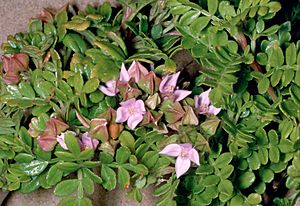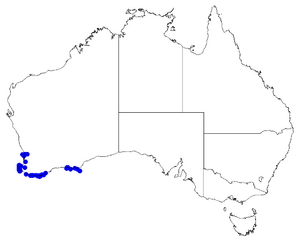Winged boronia facts for kids
Quick facts for kids Winged boronia |
|
|---|---|
 |
|
| Boronia alata at Cape Naturaliste | |
| Scientific classification | |
| Genus: |
Boronia
|
| Species: |
alata
|
 |
|
| Occurrence data from Australasian Virtual Herbarium | |
| Synonyms | |
|
|
The Boronia alata, also called the winged boronia, is a beautiful flowering shrub. This plant naturally grows only in Southwest Australia. However, people have also started growing it in other places as a garden plant.
Contents
What Does Winged Boronia Look Like?
The winged boronia is a shrub that grows upright with many branches. It can reach about 2.5 m (8 ft) tall and wide. In windy, open areas, it might stay very short, sometimes only 0.3 m (1 ft) high.
Leaves and Stems
Its leaves are made up of smaller leaflets, usually seven to thirteen of them. The whole leaf is about 15–65 mm (0.6–3 in) long and 10–40 mm (0.4–2 in) wide. The stem that holds the leaf (called a petiole) is 4–18 mm (0.2–0.7 in) long. The small leaflets are shiny and dark green on top, but lighter underneath.
Flowers and Fruit
The flowers are usually pink, but sometimes they can be white. They grow in large groups at the ends of branches. Each flower has four sepals (small leaf-like parts that protect the bud) and four petals. The petals are 7–12 mm (0.3–0.5 in) long. Inside the flower, there are eight stamens (the parts that make pollen).
The winged boronia flowers from July to December. After flowering, it produces small, hairy fruits. These fruits are like little seed pods, about 4–5 mm (0.16–0.20 in) long.
Where Does Winged Boronia Grow?
This shrub is found in the southwestern part of Australia. Most of the places where it grows are near the coast. You can find it in areas like the Esperance Plains, Jarrah Forest, and Swan Coastal Plain. It likes to grow in thick plants on sand dunes and limestone cliffs.
Growing Winged Boronia in Gardens
People grow Boronia alata because it's a lovely ornamental plant. You can start new plants from cuttings. Like most boronia plants, it prefers a spot with a lot of shade.
Caring for Your Plant
The flowers usually appear in the Australian spring. They are more open and star-shaped than other boronia flowers. They are typically pink or sometimes white. To help it grow well, you should plant it in sandy soil that drains water easily. Adding a thick layer of mulch or sandstone can help keep the soil moist and protect the roots from getting too hot.
This plant was first brought to English gardens in 1824. It was grown in greenhouses and flowered from May to July there. The flowers have a light, pleasant smell.

